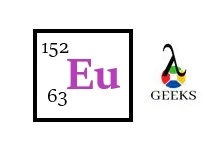Europium properties are referring the chemical and physical facts about the periodic element Europium. Let us define the chemical properties of Europium below:
Europium properties can be defined as some evidences for establishing chemical identity of Europium element. These evidences helped Mendeleev to put this element in the periodic table at a specific position. The properties hold different factors for making unique verification of the element.
There are general properties that helped Mendeleev to choose a certain number elements in a specific area of the periodic table. Europium’s properties such as its atomic number, melting and boiling points, electronegativity and others are key factors that would be discussed throughout this article.
Europium symbol
The symbol of Europium is Eu. The first two letters from ‘Europium’ are uniquely used to denote this element in chemical reactions.
Europium group in periodic table
Europium cannot be put in any specific group in the periodic table as this comes under lanthanide elements and it is the most reactive element in the nature.
Europium period in periodic table
Europium is placed at 6th period of periodic table as the entire series of Lanthanides are out at this period.
Europium block in periodic table
Europium can be found in f block. This element is noticed to possess f orbitals in atomic structure that is the reason behind putting it in f block. However, all the Lanthanides have f atomic orbital.
Europium atomic number
The atomic number of Europium is 63. It means the elements has 63 electrons and 63 protons to balance negative and positive charges respectively inside a Europium atom.

Europium atomic Weight
The atomic weight of Europium is 151.964 u and here atomic weight is a related term for atomic mass in chemistry.
Europium Electronegativity according to Pauling
The amount of electronegativity in Pauling scale imposed by Europium is 1.2 and electronegativity appears as a relative term so it is unitless and measured in Pauling scale.
Europium atomic Density
The atomic density of Europium is 5.244 g/cm3.
Europium melting point
Europium has a melting point of 826 °C (1099 K, 1519 °F).
Europium boiling point
The boiling point of Europium has been obtained as 1529 °C (1802 K, 2784 °F).
Europium Van der Waals radius
Van der Waals radius of a Europium atom is 240 pm. Though the atomic radius is noticed to be 180 pm, the radius of imaginary hard sphere of Eu atom can be found larger than its normal atomic radius.
Europium ionic/covalent radius
The covalent radius of Europium has been calculated as approximately 198 pm. This distance between two mutually bonded Europium atom is noticed to differ in the range of 192 to 204 pm.
Europium isotopes
Isotopes are referred as the types of atoms that differ by the number the total number of nucleons present in them. Let us identify the isotopes of Europium.
There are two stable isotopes of Europium naturally occur that are 151Eu and 153Eu and the half-life of 151Eu isotope is 5×1018 y.
Europium electronic shell
Electronic shell refers to the space inside an atom around the nucleus of periodic elements where electrons are arranged. Let us identify the electronic shell of Europium here.
Europium has 6 electronic shell and 5 of them are filled with electrons as per the highest capacity of the shells. Only the last shell of Europium is noticed with 2 electrons.
Europium energy of first ionisation
The first ionisation energy of Europium is 547.1 kJ/mol, which means that 547.1 kJ of external heat or energy is required to reduce one electron from the last electronic shell of Europium atom.
Europium energy of second ionisation
The second ionisation energy of Europium is obtained as 1085 kJ/mol that means 1085 kJ of energy is required to leave the second last electron of Eu2+ ion.
Europium energy of third ionisation
Third ionisation energy is 2404 kJ/mol for Eu+ ion, which is comparatively much higher because after being stabilised with filled valence shell Eu atom does not want to leave any electron.
Europium oxidation states
Europium shows three oxidation states; 0, +2, +3 and a single Eu atom can leave highest three electron from its electronic shell.
Europium electron configurations
Electronic configuration of Europium atom is [Xe] 4f7 6s2 that is arranged by Aufbau principle. Xenon is the nearest noble gas placed at the same period so Eu atom has a tendency to be stable as Xenon in the periodic table. That is why this noble gas is written as ideal one before its configuration.
Europium CAS number
The CAS (Chemical Abstracts Service) registration number of Europium is 7440-53-1.
Europium ChemSpider ID
The identification number of Europium in ChemSpider database is 22417.
Europium allotropic forms
Allotropic forms are the different atoms of one specific element with different structural format. Let us find if Europium has any allotropic forms or not below.
Europium has no allotropic forms. It belongs in one stable structure with face-centred cubic geometry. The contribution of these elements has no significance in nature and it is highly reactive so the element has no allotropes.
Europium chemical classification
Europium is found as the rare-earth element, which is found the most reactive in lanthanide series. This is a shiny fresh metal with superconductivity. These are the most relevant chemical properties of Europium to classify the element among Lanthanides with unique verification.
Europium state at room temperature
Europium is found as a solid but softest lanthanide metal at room temperature.
Is Europium paramagnetic?
Paramagnetic elements are those who have unpaired electrons in the elements. Let us find if Europium shows any paramagnetic behaviour or not.
Europium is a paramagnetic element as it has an unpaired electron in f orbital and it shows an unusual magnetic behaviour also.
Conclusion
Europium has been found as the most reactive but softest Lanthanide element. It cannot be classified in any particular group of the periodic table due its large size. This element is found to be rarely unique being one of the rarest earth metal.

Hi…..I am Sarnali Mukherjee, a graduate from the University of Calcutta. I love to teach and share knowledge on chemistry. I have gradually gained interest in article writing since one year ago. I would love to acquire more knowledge on my subject in the future.
Let’s connect through LinkedIn: